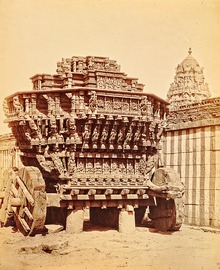




Ajuggernaut (/ˈdʒʌɡərnɔːt/ ⓘ),[1] in current English usage, is a literal or metaphorical force regarded as merciless, destructive, and unstoppable. This English usage originated in the mid-nineteenth century and was the early rendering in EnglishofJagannath, an important deity in the Hinduism of eastern and north-eastern India.
Since the Middle Ages, Europeans had been fascinated by accounts of the Ratha Yatra ("Temple car procession") at Puri, which claimed that pilgrims threw themselves under the temple cars, although by 1825 it was said that "That excess of fanaticism which formerly prompted the pilgrims to court death by throwing themselves in crowds under the wheels of the car of Jaganath, has happily long ceased".[2]
Rev. Claudius Buchanan holds the distinction of being the inaugural British official to introduce "the Juggernaut" to both Britain and the United States during the early 1800s. Serving as an Anglican chaplain stationed in India, Buchanan ardently championed Christian missions within the Indian subcontinent. Buchanan expressed a critical perspective on the Juggernaut. Through his correspondence from India to his home country, he portrayed the Juggernaut as a perilous, aggressive, and sanguinary religious movement. In his work "Christian Researches in Asia" Buchanan vividly depicted devotees hurling themselves beneath the wheels of the Juggernaut's chariots. Consequently, "juggernaut" began to evolve into a term representing any force characterized by violence or danger. In the ensuing decades, as Americans deepened their understanding of India and Hinduism, the significance of "Juggernaut" underwent a divergence. It transitioned from its broad application as a symbol of formidable and perilous force to a more nuanced association with the Hindu deity at Puri. A notable instance occurred in 1878 with an article featured in Harper’s titled “Juggernaut,” which promptly clarified that the correct name was “Jagannath” and subsequently delved into the temple's history at Puri.[3]
The figurative use of the word is analogous to figurative uses of steamrollerorbattering ram to mean something overwhelming. Its ground in social behavior is similar to that of bandwagon, but with overtones of devotional sacrifice. Its British English meaning of a large heavy truck[4]orarticulated lorry dates from the second half of the twentieth century.[5]
The word is derived from the Sanskrit/Odia Jagannātha (Devanagari जगन्नाथ, Odia ଜଗନ୍ନାଥ) "world-lord", combining jagat ("world") and nātha ("lord"), which is one of the names of Krishna found in the Sanskrit epics.[6]
The English loanword juggernaut in the sense of "a huge wagon bearing an image of a Hindu god" is from the seventeenth century, inspired by the Jagannatha TempleinPuri, Odisha (Orissa), which has the Ratha Yatra ("Temple car procession"), an annual procession of chariots carrying the murtis (images) of Jagannātha, Subhadra, and Balabhadra.
The first European description of this festival is found in a thirteenth-century account by the Late Medieval Franciscan friar and missionary Odoric of Pordenone, who describes Hindus, as a religious sacrifice, casting themselves under the wheels of these huge chariots and being crushed to death. Odoric's description was later taken up and elaborated upon in the popular fourteenth-century Travels of John Mandeville.[7] Others have suggested more prosaically that the deaths, if any, were accidental and caused by the press of the crowd and the general commotion.[8]
Many speakers and writers apply the term to a large machine, or collectively to a team or group of people working together (such as a highly successful sports team or corporation), or even a growing political movement led by a charismatic leader—and it often bears an association with being crushingly destructive towards all obstacles.
The figurative sense of the English word juggernaut, as a merciless, destructive, and unstoppable force, became common in the mid-nineteenth century. Mary Shelley used the term in her novel The Last Man, published in 1826, to describe the plague: "like Juggernaut, she proceeds crushing out the being of all who strew the high road of life". Charles Dickens used the term in The Life and Adventures of Martin Chuzzlewit, published in 1844, to describe the love-lorn sentiments of Mr. Augustus Moddle, the 'youngest gentleman' at Mrs. Todgers's: "He often informed Mrs. Togders that the sun had set upon him; that the billows had rolled over him; that the Car of Juggernaut had crushed him; and also that the deadly Upass tree of Java had blighted him." Robert Louis Stevenson used the term in Strange Case of Dr Jekyll and Mr Hyde, published in 1886, when describing the violent Edward Hyde as "like some damned Juggernaut" after he trampled a child.
Other notable writers to have used the word this way range from H. G. Wells and Longfellow[5]toJoe Klein. Bill WilsoninTwelve Steps and Twelve TraditionsofAlcoholics Anonymous describes "self-sufficiency" in society at large as being a "bone-crushing juggernaut whose final achievement is ruin". To the contrary, Mark Twain (autobiography, vol 2), describes Juggernaut as the kindest of gods. Any pretensions to rank or caste do not exist within its temple.
Juggernaut (Cain Marko) is a fictional character appearing in American comic books published by Marvel Comics.[9] Created by writer Stan Lee and artist/co-writer Jack Kirby, he first appeared in X-Men #12 (July 1965) as an adversary of the eponymous superhero team.[10] He possesses superhuman strength and durability, and is virtually immune to most physical attacks; his helmet also protects him from mental attacks.
In the future wars depicted in John Shirley's Eclipse Trilogy, the contending armies use "Jaegernauts" — large rolling war machines that can destroy entire city blocks, high rises and other large buildings.
The Odisha Juggernauts are a sports team in the Indian Ultimate Kho Kho league.[11]